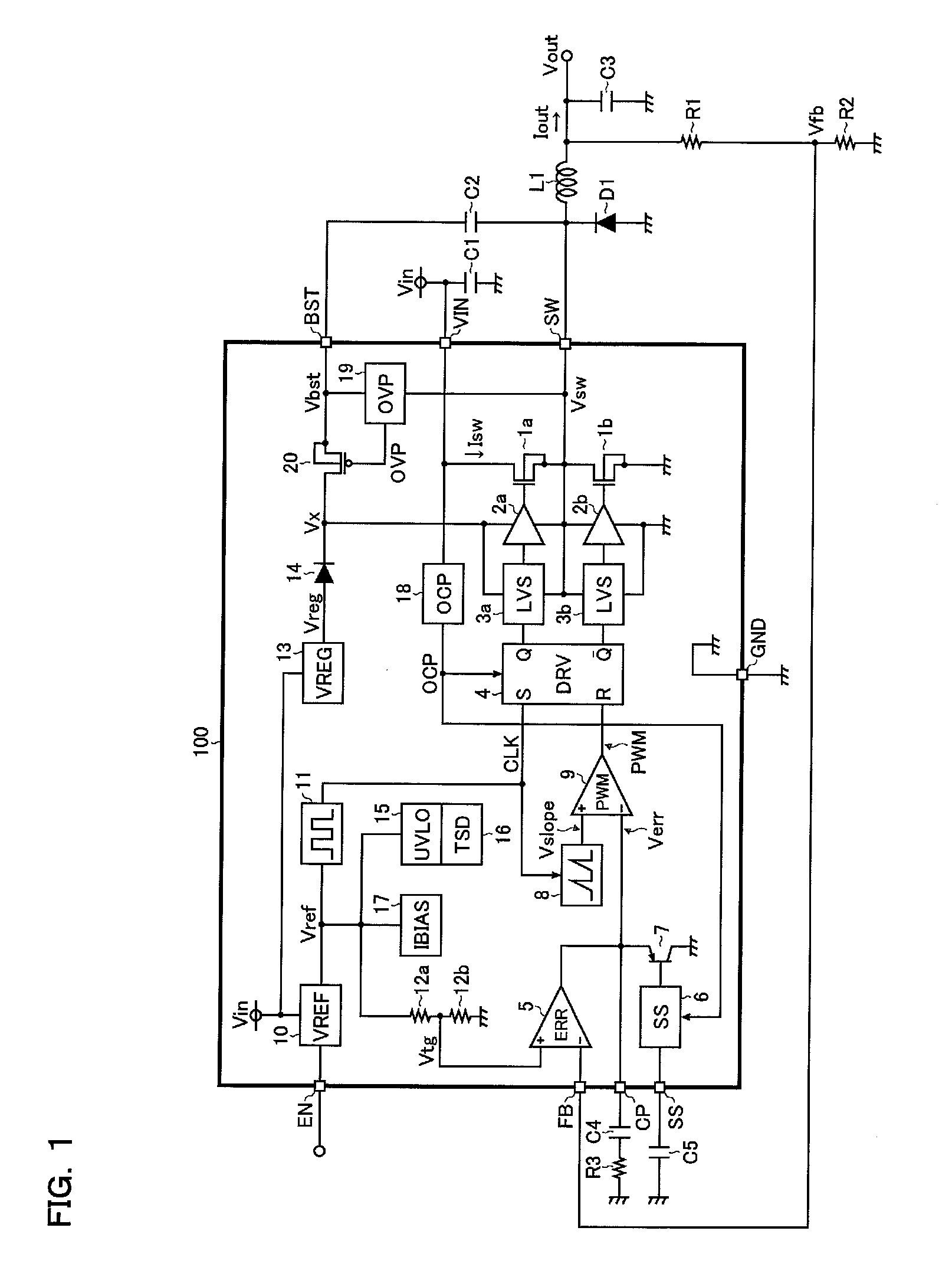Semiconductor device and switching regulator using the device
a switching regulator and semiconductor technology, applied in the direction of electric variable regulation, process and machine control, instruments, etc., can solve the problems of increasing the size and cost of the switching power supply icb>200/b>, reducing the size and cost of the switching regulator, and being more resistant to high voltage. , the effect of preventing the increase in size and cos
- Summary
- Abstract
- Description
- Claims
- Application Information
AI Technical Summary
Benefits of technology
Problems solved by technology
Method used
Image
Examples
first embodiment
[0029]FIG. 1 is a circuit block diagram depicting a first embodiment of the switching regulator. As illustrated, the switching regulator of the first embodiment is a step-down switching regulator (chopper regulator) having a switching power supply IC 100, as well as an external inductor L1, a diode D1, resistors R1 to R3, and capacitors C1 to C5, and is adapted to generate a desired output voltage Vout from an input voltage Vin.
[0030]The switching power supply IC 100 has n-channel MOS field effect transistors 1a and 1b, drivers 2a and 2b, level shifters 3a and 3b, a drive control circuit 4, an error amplifier 5, a soft start control circuit 6, a pnp bipolar transistor 7, a slope voltage generation circuit 8, a PWM (Pulse Width Modulation) comparator 9, a reference voltage generation circuit 10, an oscillator 11, resistors 12a and 12b, a boosting constant voltage generation circuit 13, a diode 14, an undervoltage lockout circuit 15, a thermal shutdown circuit 16, an input bias curren...
second embodiment
[0071]A conventional switching regulator (a BUCK converter using a bootstrap system) depicted in FIG. 11 has a configuration wherein the transistor 201b connected between the switch terminal SW and the ground terminal GND undergoes switching control in complementary fashion to that of a transistor 201a.
[0072]With the conventional configuration shown above, in the event that the switching current Isw drops at times of low load or no load, resulting in a condition in which ringing noise arises in the switching voltage Vsw (so-called discontinuous current mode), the ringing noise may indeed escape to the ground terminal GND through the transistor 201b. Specifically, when the transistor 201a is OFF, the switching voltage Vsw is reduced to a low level (0 V) via the transistor 201b, and the capacitor C2 connected between the bootstrap terminal BST and the switch terminal SW can be adequately charges. Therefore, when the transistor 201a subsequently is switched ON, the boost voltage Vbst ...
third embodiment
[0084]In the conventional switching regulator depicted in FIG. 11, fluctuation in the output voltage Vout is initially detected by the error amplifier 205 when the load fluctuates, and the duty of the pulse width modulation signal PWM is expanded in association with the rise of the error voltage Verr so that the output voltage Vout is maintained at the target value.
[0085]With the above-described conventional configuration, fluctuations in the output voltage Vout can indeed be kept to a minimum when the load has relatively moderate fluctuations.
[0086]However, with the above-described conventional configuration, output feedback control by the PWM method is performed after fluctuation in the output voltage Vout is detected by the error amplifier 205. Therefore, the load response speed is low, and the problem of large fluctuations in the output voltage Vout during sudden changes in load sometimes occurs. Increasing the load response speed requires increasing the operating frequency of o...
PUM
 Login to View More
Login to View More Abstract
Description
Claims
Application Information
 Login to View More
Login to View More - R&D
- Intellectual Property
- Life Sciences
- Materials
- Tech Scout
- Unparalleled Data Quality
- Higher Quality Content
- 60% Fewer Hallucinations
Browse by: Latest US Patents, China's latest patents, Technical Efficacy Thesaurus, Application Domain, Technology Topic, Popular Technical Reports.
© 2025 PatSnap. All rights reserved.Legal|Privacy policy|Modern Slavery Act Transparency Statement|Sitemap|About US| Contact US: help@patsnap.com



